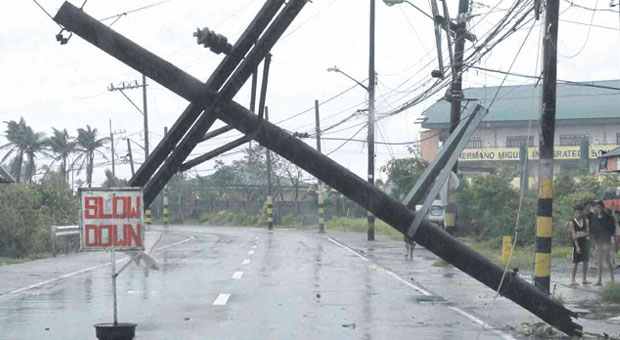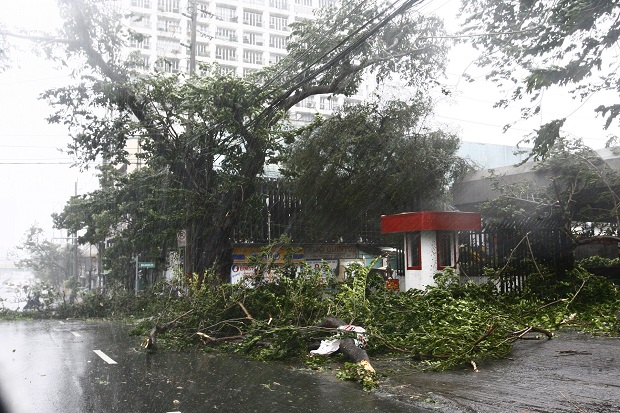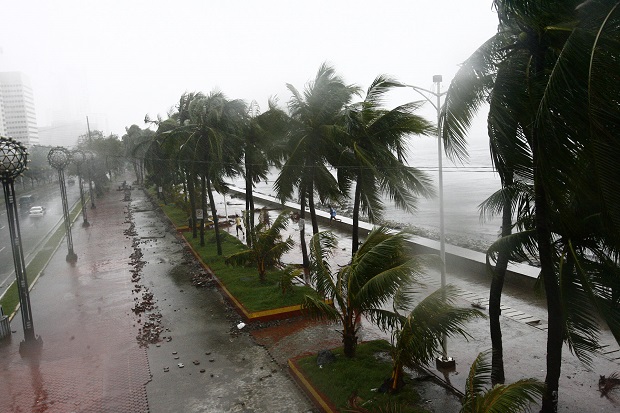Typhoon ‘Glenda’ leaves 20 dead

POWER CONSUMERS’ CALVARY An electric post is toppled at the height of Typhoon “Glenda” (international name: Rammasun) in Noveleta, Cavite province. The typhoon led to power outages affecting a total of 13.5 million people in Luzon, including Metro Manila, and the Visayas. EDWIN BACASMAS
Typhoon “Glenda” dealt Metro Manila only a glancing blow of about three hours Wednesday, but it was enough to shut down the capital, leave the megacity a shambles and without power, and take at least 20 lives as it blew out into the West Philippine Sea after cutting a wide swath of destruction from eastern to southern Luzon.
The number of fatalities in the first major typhoon of the Philippines’ brutal rainy season was hard to determine, as most parts of the stricken regions had no electricity and the main disaster agency groped in the dark for information.
The powerful winds of Glenda (international name: Rammasun, which in Thai means “God of Thunder”) brought down trees, electric posts and ripped off roofs across Metro Manila, where government offices, schools and the stock market were shuttered for the day.
Without electricity, the elevated commuter train services LRT and MRT were suspended and most of the city of 12 million people sweltered in the dark for more than half of the day.
Glenda’s powerful winds shut down the two runways servicing domestic and international flights at Ninoy Aquino International Airport (Naia) at 7 a.m., paralyzing the entire airport operations for most of the morning as the typhoon passed just south of the capital.
Article continues after this advertisementThe Civil Aviation Authority of the Philippines (Caap) opened the runways at 10:40 a.m., bringing back airport operations.
Article continues after this advertisementPlanes damaged
Not without incident, though. Glenda’s powerful wind slammed two commercial airplanes into air bridges, damaging them.
Airport officials said the left wing of a Singapore Airlines Boeing 777-200 was broken after strong typhoon winds shoved the parked aircraft to an air bridge in Terminal 1.
A parked Malaysian Airlines Boeing 737-800 was also blown away, hitting the service stairs at the terminal. The impact punctured the right side of the plane’s fuselage.
There were no injuries, as there was no one aboard the planes at the time.
“Both [incidents] happened in the morning. It was somehow rare. I can imagine how heavy an aircraft is and the two were moved by the typhoon winds,” said Danny Besanta, manager of Naia Terminal 1.
Telecommunications survived Glenda’s strong winds, with Philippine Long Distance Telephone Co. (PLDT) reporting its network facilities “were largely unscathed.”
PLDT said, however, that the power outages in Metro Manila, Southern Tagalog and south Luzon “adversely affected mobile and fixed line services in these regions.”
Power was restored to parts of the metropolis by midafternoon, bringing television and radio back.
The large shopping malls, however, threw their doors open to the public as soon as Glenda had passed.
Widespread flooding was reported in most parts of Metro Manila as Glenda whipped the metropolis.
Manila Mayor Joseph Estrada said he was relieved there were no reported deaths after Glenda sideswiped his city, although the typhoon’s winds downed trees and damaged bayside shanties, prompting more than 1,000 residents to evacuate.
“It was like a drill,” Estrada said. “We hauled people away from dangerous seaside areas, whether they liked it or not.”
The eye of Glenda passed to just south of Metro Manila at wind speeds of up to 120 kilometers per hour and with gusts of up to 165 kph.
In 2006, Typhoon “Milenyo” (Xangsane) hit the capital at 130 kph, with gusts of up to 160 kph.
In stark contrast, Super Typhoon “Yolanda” (Haiyan) struck Eastern Visayas on November 8, 2013 with sustained winds of 235 kph and gusts of up to 275 kph.
Glenda leaves the Philippine area of responsibility Thursday.
Two deaths were reported in Metro Manila as of midafternoon Wednesday.
At a meeting of the Metropolitan Manila Development Authority and Disaster Risk Reduction and Management Council, representatives reported that one person was killed in Pasig City and another died in Valenzuela City at the height of the typhoon.
Jomarck Diaz, 19, was lowering the national flag in Barangay (village) Palatiw Hall in Pasig when he was hit by falling hollow blocks.
Jackilyn Sumampong, 27, died after the wall of an abandoned factory collapsed on her house in Barangay Canumay East, Valenzuela City.
Five other people were injured in the incident.
Pateros reported two typhoon-related injuries; Quezon City, two, one of whom was in critical condition; and Makati, one, a man who was hit by flying debris as he drove a motorcycle.
The Office of Civil Defense-National Capital Region released a report that showed 3,602 families, or 16,127 people, were evacuated in Navotas, Pasay, Pasig, Parañaque, Mandaluyong, Quezon City, Muntinlupa, Manila and Taguig.
The MMDA said the evacuees were staying in at least 27 school buildings in the metropolis.

Fallen trees along España in Manila after the strong winds brought by Typhoon Glenda. INQUIRER PHOTO/ JOAN BONDOC
Four landfalls
Glenda made landfall in Albay province late Tuesday at 25 kph, with 130-kph winds and gust of 120 kph.
It slowed down to 19 kph as it made two more landfalls across the Bicol region, and was forecast to strike Manila at noon Wednesday.
But the typhoon picked up speed overnight and moved downward, making a fourth landfall in Bataan.
With wind speeds of up to 120 kph, the typhoon passed to just south of Metro Manila between 6 a.m. and 9 a.m.
Glenda’s powerful winds downed power lines in the Bicol region and parts of the Visayas.
The main disaster agency, National Disaster Risk Reduction and Management Council (NDRRMC), said the provinces without power were Sorsogon, Eastern Samar, portions of Samar including Calbayong City and parts of Northern Samar.
NDRRMC Executive Director Alexander Pama told a news briefing Wednesday afternoon that heavy damage could be expected in Quezon, as the entire province received a battering from Glenda.
Pama said the agency had not received “significant reports” from other typhoon-hit areas, including Metro Manila.
20 dead
Television news reports Wednesday night put the death toll at 20, but disaster officials struggling with limited communication facilities due to the widespread power loss reported 18 people dead, one person missing, and thousands jamming evacuation centers in Calabarzon (Cavite, Laguna, Batangas, Rizal and Quezon).
In Quezon province alone, 10 people were reported killed at the height of the typhoon, but the NDRRMC had no statement about the report as of Wednesday afternoon.
Three of the 10 were killed after the concrete wall of an abandoned house fell on their house in Lucena City.
The Calabarzon disaster council also reported three people, one of them a child, died in General Trias, Dasmariñas City and Rosario town in Cavite.
Three people also died in Rizal, two in Laguna, and one was missing in Batangas, the disaster council said.
An interisland vessel based in Cebu ran aground in Sta. Clara town in Batangas City after being hit by Glenda’s strong winds at around 3 a.m.
The Philippine Coast Guard identified the vessel as the Supershuttle Ro-Ro 5, owned and operated by Asian Marine Transport Corp.
Coast guards were deployed to assist the vessel’s crew, the agency said.

Trees blown by strong winds brought by Typhoon Glenda along Roxas Bloulevard.
INQUIRER PHOTO/ JOAN BONDOC
‘Boring’
Defense Secretary Voltaire Gazmin and other Cabinet officials conducted an aerial survey of the metropolis and surrounding provinces Wednesday afternoon.
Public Works Secretary Rogelio Singson said he found the survey “boring,” as he did not see flooding on major roads.
He reported “minimal flooding” in major roads in Metro Manila, including flood-prone parts like Magallanes, Lagusnilad and España Avenue, and even in low-lying areas like Malabon and Navotas.
Singson was satisfied that Maricaban Creek did not overflow and cause flooding in Makati City and Pasay City.
He said even the coastal towns in Cavite province did not experience flooding.
Singson said fallen trees and electric posts or landslides closed segments of three national roads in Bataan, Aurora and Pampanga; four national roads and a city bridge in Batangas; and two segments of national roads in Mindoro and Marinduque.
But national roads in Albay and Sorsogon had been cleared, as well as national roads in Eastern Visayas, he said.
He said roads were being cleared in the provinces of Zambales and Bataan, both landslide-prone areas.
Communications Secretary Herminio Coloma reported “minimal infrastructure damage and casualties” from Glenda.
More than 150,000 people were evacuated to higher grounds in coastal villages before the typhoon hit land, saving many lives.
Haunted by Super Typhoon Yolanda, which killed thousands, the residents of towns and villages in Glenda’s path cooperated with the authorities and were saved from death and injury.
Casualties
Still four people were killed in Negros Oriental, Northern Samar and Iloilo provinces.
Among the four was a nurse who was killed after she was hit by a falling electric post in Allen town, Northern Samar, while going home late Tuesday as the typhoon whipped the province.
Verneil Balaba of the regional Office of Civil Defense (OCD) said Glenda caused only minor damage in Cebu province.
An Indonesian barge ran aground off the wharf in Minglanilla town, southern Cebu, after it was unmoored by strong winds in adjacent Naga City at about 10:30 a.m. No one was injured, Minglanilla police said.
Glenda caused flooding in Iloilo, Antique and Capiz provinces, the OCD said.
In the Mimaropa (Mindoro, Marinduque, Romblon, Palawan) region, authorities reported three deaths and nearly 5,000 people evacuated to safer grounds.
In Central Luzon, two people were killed after being pinned down by falling trees in Bulacan and Zambales provinces.
Carrie Aspa, Zambales provincial information officer, said three people were injured in typhoon-related incidents in the towns of Castillejos, San Narciso and San Antonio.
Power went out as Glenda crossed Zambales about noon.
The regional disaster council said the Angat, Ipo and Bustos dams in Bulacan and Pantabangan Dam in Nueva Ecija province posed no threat to residents, as the water in these reservoirs remained at normal levels despite the rains brought by Glenda.
Thousands of people were evacuated to avoid floods and landslides in the region, but they were expected to return to their homes as the weather improved Thursday.
Police help
The Philippine National Police reminded the evacuees to make sure their homes had no major damage before entering them when they returned.
PNP Director General Alan Purisima directed all police units to coordinate closely with and support local governments and disaster officials in assisting evacuees in returning to their homes.
Areas that declared a state of calamity have been placed under a price freeze to ensure the prices of basic goods remain stable in the aftermath of Glenda, Trade Undersecretary Victorio Dimagiba said.
Bataan, Albay, Camarines Sur, Camarines Norte, Cavite, Gumaca in Quezon, and Muntinlupa City have declared a state of calamity. Reports from Dona Pazzibugan, Niña P. Calleja, Miguel R. Camus, Kristine Felisse Mangunay, Jerry E. Esplanada, Marlon Ramos and Amy R. Remo in Manila; Jhunnex Napallacan, Nestor P. Burgos Jr., Carmel Loise Matus, Joey A. Gabieta and Jennifer Allegado, Inquirer Visayas; Allan Macatuno, Tonette Orejas, Greg Refraccion, Carmela Reyes-Estrope, Anselmo Roque and Armand Galang, Inquirer Central Luzon; Gabriel Cardinoza and Kimberlie Quitasol, Inquirer Northern Luzon; Maricar Cinco, Romulo Ponte, Delfin T. Mallari Jr. and Jofel Joyce Lancion, Inquirer Southern Luzon; Inquirer Archives; AP and AFP
RELATED STORIES
7 areas placed under state of calamity
4.6M Meralco customers without electricity due to ‘Glenda’